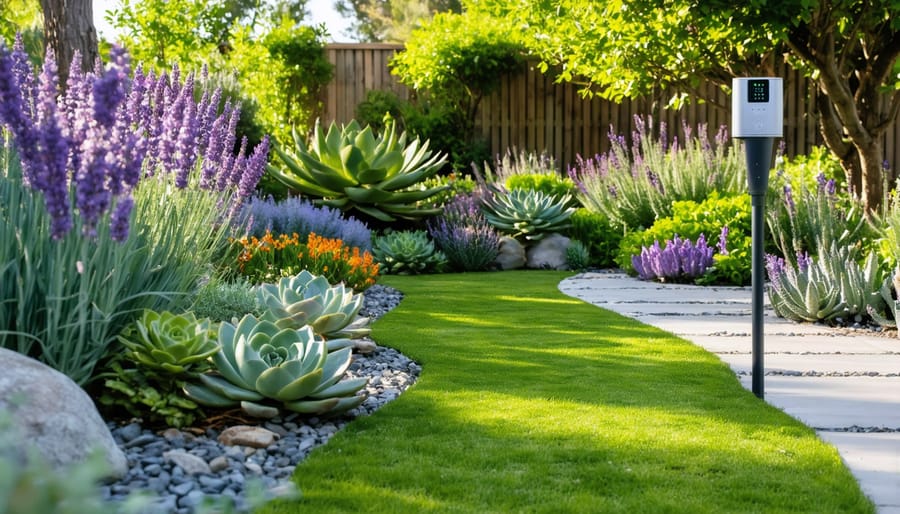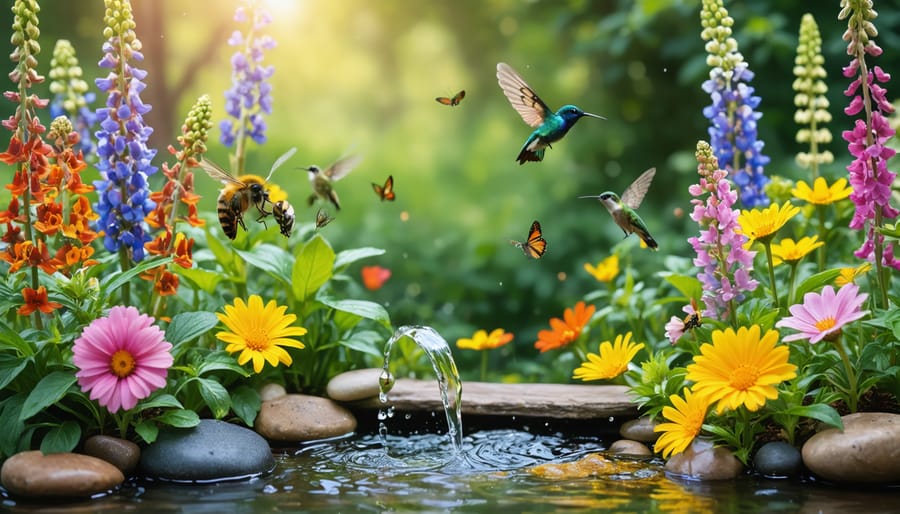Transform your garden into a water-saving oasis by selecting drought-resistant native plants that thrive in your local climate while requiring minimal irrigation. Group plants with similar water needs together, creating hydrozones that maximize irrigation efficiency and reduce water waste. Install a smart drip irrigation system connected to moisture sensors, delivering precise amounts of water directly to plant roots during optimal morning hours. Layer your soil with organic mulch 2-3 inches deep to retain moisture, suppress water-hungry weeds, and create a thriving ecosystem that naturally conserves water.
In an era where water conservation has become critical, water-efficient gardens represent the perfect blend of environmental responsibility and stunning landscape design. These sustainable spaces not only reduce water consumption by up to 50% but also create resilient, low-maintenance environments that flourish even during water restrictions. By combining smart irrigation technology, climate-appropriate plant selection, and proper soil management, your garden can become a model of water efficiency without sacrificing its natural beauty.
Smart Plant Selection for Maximum Water Savings
Native Plants: Your Garden’s Best Friend
Native plants are nature’s perfect solution for creating a water-efficient garden that thrives with minimal maintenance. These plants have evolved over thousands of years to flourish in your local climate, making them naturally adapted to rainfall patterns and soil conditions in your area.
In the Southwest, drought-resistant beauties like Purple Coneflower, Black-Eyed Susan, and Butterfly Weed create stunning displays while sipping minimal water. Pacific Northwest gardeners can enjoy the deep purples of Douglas Aster and the cheerful yellows of Oregon Sunshine, both of which handle the region’s unique weather patterns beautifully.
For Midwest gardens, Prairie Blazing Star and Wild Bergamot offer vibrant colors while naturally managing both drought and occasional flooding. East Coast gardeners will find joy in Cardinal Flower and New England Aster, which provide reliable blooms without demanding extra irrigation.
Beyond water efficiency, native plants offer a host of benefits. They create essential habitats for local wildlife, including pollinators like butterflies and bees. Their deep root systems help prevent soil erosion and improve drainage. Best of all, these plants typically require less fertilizer and fewer pesticides than non-native species.
To find the perfect natives for your garden, consider consulting your local extension office or native plant society. They can recommend species that will thrive in your specific microclimate while contributing to local biodiversity.
Drought-Resistant Superstars
Looking to create a water-efficient oasis? These drought-resistant plants are true garden heroes that will thrive with minimal water while adding stunning beauty to your landscape.
Lavender stands out as a Mediterranean marvel, offering fragrant purple blooms and silvery foliage that barely breaks a sweat in dry conditions. Its deep roots help it access water far below the surface, making it incredibly self-sufficient.
Sedum, often called stonecrop, is a succulent superstar that stores water in its thick leaves. Available in various colors and heights, it provides eye-catching texture and reliable blooms even during the driest spells.
Russian Sage brings airy purple spikes that dance in summer breezes, attracting pollinators while requiring barely more than rainfall to flourish. This hardy perennial looks stunning paired with ornamental grasses like Blue Fescue, another water-wise champion.
For groundcover, consider Creeping Thyme or Ice Plant. Both spread beautifully to create living carpets that suppress weeds and require minimal irrigation. Their colorful blooms are an added bonus that pollinators adore.
Don’t forget natives like Black-Eyed Susan and Butterfly Weed. These plants have evolved to thrive in your local climate, making them naturally adapted to your area’s rainfall patterns. Plus, they provide essential habitat for local wildlife.
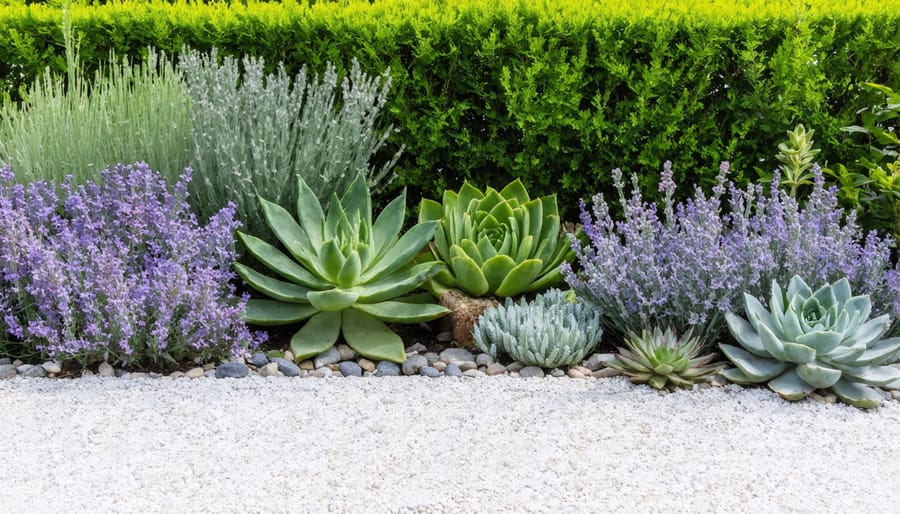
Modern Irrigation Methods That Actually Work
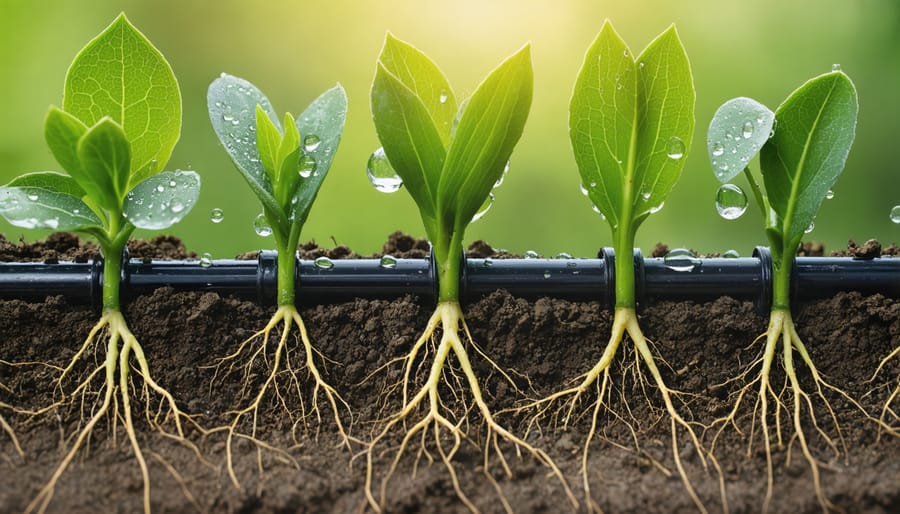
Drip Irrigation: The Water-Saving Champion
Drip irrigation stands out as one of the most efficient watering methods available to home gardeners, delivering water directly to plant roots while minimizing waste. This clever system uses a network of tubes and emitters to provide slow, steady moisture exactly where plants need it most.
Setting up a basic drip system is simpler than you might think. Start with a timer-equipped outdoor faucet connection, then run a main line through your garden beds. From there, smaller distribution tubes branch out to individual plants or rows. The real magic happens through emitters – small devices that regulate water flow – which you can customize based on each plant’s needs.
What makes drip irrigation so effective? Water is delivered slowly and steadily at ground level, allowing soil to absorb moisture gradually without runoff. This targeted approach means water isn’t lost to evaporation or wind drift, unlike with traditional sprinklers. Plus, by keeping foliage dry, you’ll reduce the risk of fungal diseases that thrive in wet conditions.
For best results, cover your drip lines with mulch to further reduce evaporation and protect the tubes from sun damage. Consider installing a rain sensor to prevent unnecessary watering during wet weather. You can even connect your system to a smart controller that adjusts watering schedules based on weather conditions.
While the initial setup requires some planning and investment, the water savings typically pay for the system within a few seasons. Many gardeners report using 30-50% less water after switching to drip irrigation, all while maintaining healthier, more productive plants.
Smart Controllers and Sensors
Modern technology has revolutionized the way we manage water in our gardens, making conservation easier and more effective than ever before. Smart controllers and sensors work together to create an intelligent watering system that responds to your garden’s actual needs, rather than relying on fixed schedules.
At the heart of these systems are smart irrigation controllers, which act like miniature weather stations for your garden. These devices connect to your local weather data and automatically adjust watering schedules based on rainfall, temperature, and seasonal changes. Many can be controlled through smartphone apps, allowing you to monitor and adjust your garden’s watering from anywhere.
Soil moisture sensors are particularly game-changing. These small devices are placed in your garden soil and continuously monitor moisture levels, ensuring plants receive water only when they truly need it. When the soil becomes too dry, the sensors signal your irrigation system to start watering, and when adequate moisture is detected, they shut it off automatically.
Rain sensors are another valuable addition, preventing your irrigation system from running during or immediately after rainfall. This simple but effective technology can reduce water waste significantly, especially in regions with unpredictable weather patterns.
For those interested in detailed monitoring, flow meters can track your garden’s water usage over time, helping you identify potential leaks and optimize your watering patterns. Some advanced systems even offer zone-specific control, allowing different areas of your garden to receive varying amounts of water based on plant types and sun exposure.
While these technologies require an initial investment, they typically pay for themselves through reduced water bills and healthier plants that thrive with precise irrigation.
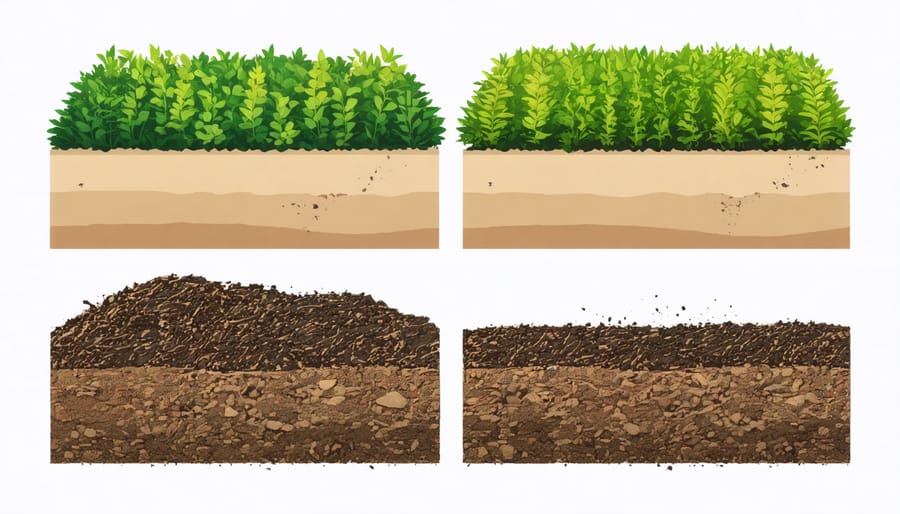
Soil Strategies for Better Water Retention
Mulching Magic
Mulching is one of the most effective ways to conserve water in your garden, acting like a protective blanket that keeps moisture locked in the soil. A good 2-3 inch layer of mulch can reduce water evaporation by up to 70%, making it a game-changer for water-efficient gardening.
Organic mulches, such as straw, bark chips, or leaf litter, not only retain moisture but also break down over time to enrich your soil. Pine bark is particularly effective in sandy soils, while shredded leaves work wonders in clay-heavy gardens. For vegetable gardens, clean straw or grass clippings provide excellent moisture retention while keeping fruits and vegetables off the ground.
Inorganic options like gravel or pebbles offer permanent solutions, especially in drought-prone areas. These materials work particularly well around succulents and Mediterranean plants, reflecting heat and reducing evaporation. A layer of landscape fabric underneath prevents them from mixing with the soil.
Pro tip: Apply mulch when the soil is moist but not waterlogged, and keep it a few inches away from plant stems and tree trunks to prevent rot. Refresh organic mulch annually in spring or fall, adding a new layer as the old one breaks down. During hot summers, consider adding an extra inch of mulch to provide additional protection against moisture loss and keep your garden thriving with less water.
Soil Amendments That Work
The key to a water-efficient garden lies in creating soil that acts like a sponge, holding moisture where plants need it most. Adding organic matter is your secret weapon in this endeavor. Compost is the garden’s best friend, improving both water retention and soil structure when mixed into your existing soil at a ratio of about 30% compost to 70% native soil.
Aged manure works wonders too, but be sure it’s well-composted to avoid burning your plants. For clay soils, adding peat moss helps break up heavy particles while increasing water-holding capacity. In sandy soils, coconut coir has become a popular alternative to peat moss, as it’s both sustainable and excellent at retaining moisture.
Vermiculite and perlite, though similar in appearance, serve different purposes. Vermiculite holds onto water like tiny reservoirs, while perlite creates air pockets that prevent soil compaction. A combination of both can create the perfect growing environment for most plants.
Don’t forget about mulch – a 2-3 inch layer of organic mulch like wood chips, straw, or leaf mold can reduce water evaporation by up to 70%. Applied on top of your amended soil, mulch acts as a protective blanket, keeping moisture in and weeds out while gradually decomposing to add even more organic matter to your soil.
Garden Layout and Design Tricks
Creating an effective water-wise garden design starts with thoughtful planning and strategic layout decisions. Begin by mapping your garden’s sunny and shady areas, as this will help you group plants with similar water needs together – a practice known as hydrozoning.
Consider creating distinct garden zones based on water requirements. Place thirstier plants in naturally moist areas or spots where water naturally collects. Reserve sunny, exposed areas for drought-resistant plants that thrive with minimal irrigation. This smart positioning significantly reduces overall water consumption while ensuring each plant gets what it needs to flourish.
Maximize water efficiency by incorporating curves and contours into your garden design. Gentle slopes and swales can direct water flow to where it’s needed most, while berms (raised areas) can create natural barriers that keep water in desired locations. Think of your garden as a series of mini-watersheds working together.
When planning pathways and hardscaping, opt for permeable materials like gravel or spaced pavers that allow water to seep into the soil rather than run off. Consider creating slightly depressed areas around trees and large shrubs to capture rainwater naturally.
Another clever design trick is to arrange plants in triangular patterns rather than straight rows. This approach not only creates visual interest but also provides better ground coverage, reducing water evaporation from exposed soil. Place taller plants behind shorter ones to create natural shade and wind protection, further reducing water loss.
Don’t forget about vertical spaces! Living walls and climbing plants can add dimension to your garden while making efficient use of available space and water resources. They also provide natural cooling effects for nearby structures, potentially reducing overall water needs.
Remember, a well-designed water-efficient garden doesn’t mean sacrificing beauty – it’s about working smarter with nature’s patterns to create a sustainable and stunning outdoor space.
Creating a water-efficient garden isn’t just about conserving resources – it’s about building a sustainable, thriving outdoor space that works in harmony with nature. By implementing the strategies we’ve discussed, from choosing drought-resistant plants to installing smart irrigation systems and improving soil quality, you can dramatically reduce your garden’s water consumption while maintaining its beauty and productivity.
Remember that every small change matters. Start with simple steps like adding mulch or adjusting your watering schedule, then gradually incorporate more advanced techniques as you become comfortable. Many gardeners find that their plants actually become healthier and more resilient once they transition to water-efficient practices, as these methods often encourage deeper root growth and stronger plants overall.
The benefits extend beyond water conservation – you’ll likely see lower utility bills, reduced maintenance time, and a garden that’s better equipped to handle climate challenges. Plus, you’ll be contributing to environmental sustainability in your community.
Don’t feel pressured to transform your garden overnight. Take it one step at a time, experiment with different approaches, and adjust based on what works best in your specific environment. The most successful water-efficient gardens are those that evolve gradually with careful observation and thoughtful adjustments.
Start your water-efficient journey today – your garden, your wallet, and our planet will thank you for it.

